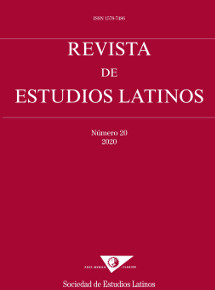Mulier or the age of puberty: primary meaning and etymological origin
DOI:
https://doi.org/10.23808/rel.v20i0.86656Keywords:
muliar[; etimología; polisemia; familia léxica; campo semántico.Abstract
Mulier, which may well have been first attested as the form muliar[ in the Corcolle altar fragments (first half of 5th c. BC), has no clear etymon and a review of its study to date does not provide us with a convincing explanation. We must widen our methodological approach, therefore, and explore the lesser-travelled routes of research into its polysemy, lexical family, and semantic field. This paper identifies the primary meaning of mulier as that of ‘female human adolescent’, as opposed to puella ‘girl’. Its meaning is analogous to that of uir (‘male human adolescent’) as opposed to puer ‘boy’. The root of mul-ier is the same as that of mul-g-ēre ‘to milk’ (cf. En. mil-k, Germ. Mil-ch) and it should also be linked with variant 8. mel- ‘to appear, come up’ in Pokorny (1959: 721-722), which is used to designate objects with a convex or conical shape and may have been applied to the breasts. With the addition of the intensive suffix -jes, *mel-jes > *mol-jes > mul-ier must have the etymological meaning ‘that activates the breasts’. The fact that femina, as a ‘female animal’, has a similar origin and parallel evolution to mulier, to the point that it has become its best substitute, supports its origin and polysemic trajectory.
Downloads
Downloads
Published
How to Cite
Issue
Section
License
Copyright (c) 2020 Revista de Estudios Latinos

This work is licensed under a Creative Commons Attribution-NonCommercial-NoDerivatives 4.0 International License.
The originals published in the printed and electronic editions of this journal are the property of the Revista de Estudios Latinos and can be circulated as long as the original source and authorship is made clear in any reproduction, full or partial, of the same, and as long as this is not done for commercial purposes.






